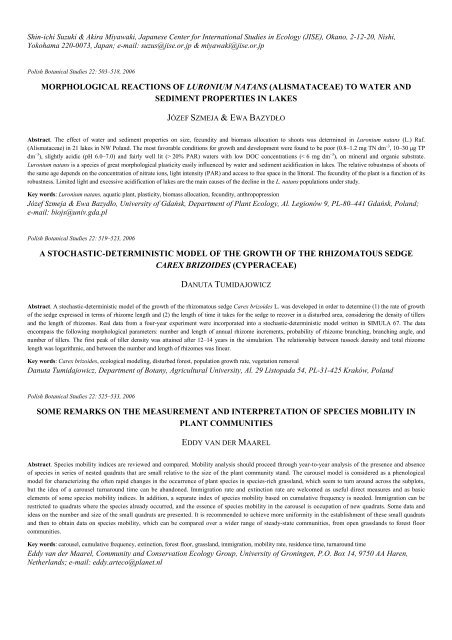Polish Botanical Studies 22 (2006)
Polish Botanical Studies 22 (2006)
Polish Botanical Studies 22 (2006)
Create successful ePaper yourself
Turn your PDF publications into a flip-book with our unique Google optimized e-Paper software.
Shin-ichi Suzuki & Akira Miyawaki, Japanese Center for International <strong>Studies</strong> in Ecology (JISE), Okano, 2-12-20, Nishi,<br />
Yokohama <strong>22</strong>0-0073, Japan; e-mail: suzus@jise.or.jp & miyawaki@jise.or.jp<br />
<strong>Polish</strong> <strong>Botanical</strong> <strong>Studies</strong> <strong>22</strong>: 503–518, <strong>2006</strong><br />
MORPHOLOGICAL REACTIONS OF LURONIUM NATANS (ALISMATACEAE) TO WATER AND<br />
SEDIMENT PROPERTIES IN LAKES<br />
JÓZEF SZMEJA & EWA BAZYDŁO<br />
Abstract. The effect of water and sediment properties on size, fecundity and biomass allocation to shoots was determined in Luronium natans (L.) Raf.<br />
(Alismataceae) in 21 lakes in NW Poland. The most favorable conditions for growth and development were found to be poor (0.8–1.2 mg TN dm –3 , 10–30 µg TP<br />
dm –3 ), slightly acidic (pH 6.0–7.0) and fairly well lit (> 20% PAR) waters with low DOC concentrations (< 6 mg dm –3 ), on mineral and organic substrate.<br />
Luronium natans is a species of great morphological plasticity easily influenced by water and sediment acidification in lakes. The relative robustness of shoots of<br />
the same age depends on the concentration of nitrate ions, light intensity (PAR) and access to free space in the littoral. The fecundity of the plant is a function of its<br />
robustness. Limited light and excessive acidification of lakes are the main causes of the decline in the L. natans populations under study.<br />
Key words: Luronium natans, aquatic plant, plasticity, biomass allocation, fecundity, anthropopression<br />
Józef Szmeja & Ewa Bazydło, University of Gdańsk, Department of Plant Ecology, Al. Legionów 9, PL-80–441 Gdańsk, Poland;<br />
e-mail: biojs@univ.gda.pl<br />
<strong>Polish</strong> <strong>Botanical</strong> <strong>Studies</strong> <strong>22</strong>: 519–523, <strong>2006</strong><br />
A STOCHASTIC-DETERMINISTIC MODEL OF THE GROWTH OF THE RHIZOMATOUS SEDGE<br />
CAREX BRIZOIDES (CYPERACEAE)<br />
DANUTA TUMIDAJOWICZ<br />
Abstract. A stochastic-deterministic model of the growth of the rhizomatous sedge Carex brizoides L. was developed in order to determine (1) the rate of growth<br />
of the sedge expressed in terms of rhizome length and (2) the length of time it takes for the sedge to recover in a disturbed area, considering the density of tillers<br />
and the length of rhizomes. Real data from a four-year experiment were incorporated into a stochastic-deterministic model written in SIMULA 67. The data<br />
encompass the following morphological parameters: number and length of annual rhizome increments, probability of rhizome branching, branching angle, and<br />
number of tillers. The first peak of tiller density was attained after 12–14 years in the simulation. The relationship between tussock density and total rhizome<br />
length was logarithmic, and between the number and length of rhizomes was linear.<br />
Key words: Carex brizoides, ecological modeling, disturbed forest, population growth rate, vegetation removal<br />
Danuta Tumidajowicz, Department of Botany, Agricultural University, Al. 29 Listopada 54, PL-31-425 Kraków, Poland<br />
<strong>Polish</strong> <strong>Botanical</strong> <strong>Studies</strong> <strong>22</strong>: 525–533, <strong>2006</strong><br />
SOME REMARKS ON THE MEASUREMENT AND INTERPRETATION OF SPECIES MOBILITY IN<br />
PLANT COMMUNITIES<br />
EDDY VAN DER MAAREL<br />
Abstract. Species mobility indices are reviewed and compared. Mobility analysis should proceed through year-to-year analysis of the presence and absence<br />
of species in series of nested quadrats that are small relative to the size of the plant community stand. The carousel model is considered as a phenological<br />
model for characterizing the often rapid changes in the occurrence of plant species in species-rich grassland, which seem to turn around across the subplots,<br />
but the idea of a carousel turnaround time can be abandoned. Immigration rate and extinction rate are welcomed as useful direct measures and as basic<br />
elements of some species mobility indices. In addition, a separate index of species mobility based on cumulative frequency is needed. Immigration can be<br />
restricted to quadrats where the species already occurred, and the essence of species mobility in the carousel is occupation of new quadrats. Some data and<br />
ideas on the number and size of the small quadrats are presented. It is recommended to achieve more uniformity in the establishment of these small quadrats<br />
and then to obtain data on species mobility, which can be compared over a wider range of steady-state communities, from open grasslands to forest floor<br />
communities.<br />
Key words: carousel, cumulative frequency, extinction, forest floor, grassland, immigration, mobility rate, residence time, turnaround time<br />
Eddy van der Maarel, Community and Conservation Ecology Group, University of Groningen, P.O. Box 14, 9750 AA Haren,<br />
Netherlands; e-mail: eddy.arteco@planet.nl
















